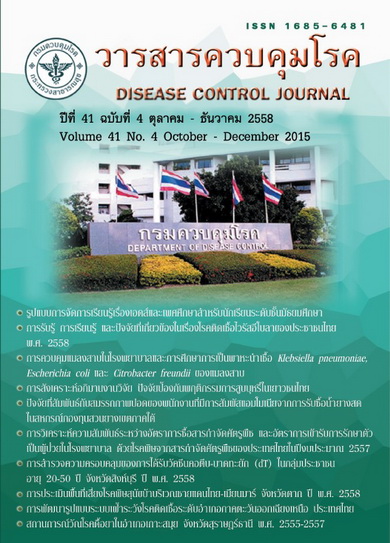การพัฒนารูปแบบระบบเฝ้าระวังโรคติดเชื้อระดับอำเภอ ภาคตะวันออกเฉียงเหนือ ประเทศไทย
DOI:
https://doi.org/10.14456//dcj.2015.9คำสำคัญ:
การพัฒนารูปแบบ, ระบบเฝ้าระวังโรคติดเชื้อบทคัดย่อ
การวิจัยเชิงปฏิบัติการ เพื่อพัฒนารูปแบบระบบเฝ้าระวังโรคติดเชื้อในระดับอำเภอ ภาคตะวันออกเฉียงเหนือ คัดเลือกสถานศึกษาแบบเจาะจงในโรงพยาบาลชุมชน 1 แห่ง สถานีอนามัย 17 แห่ง สำนักงานสาธารณสุขอำเภอ 2 แห่ง และองค์กรปกครองส่วนท้องถิ่น 17 แห่ง รวมทั้งสิ้น 37 แห่ง กลุ่มตัวอย่างที่ศึกษา คัดเลือกแบบเจาะจง เป็นบุคลากรที่เกี่ยวข้องในการดำเนินการเฝ้าระวังโรคติดเชื้อ 60 คน เก็บรวบรวมข้อมูลเชิงปริมาณ จากการทบทวนข้อมูลผู้ป่วยจากแฟ้มเวชระเบียน ส่วนข้อมูลเชิงคุณภาพ โดยการสนทนากลุ่มและการสัมภาษณ์เชิงลึก วิเคราะห์ข้อมูลคุณภาพโดยการวิเคราะห์เนื้อหา การวิเคราะห์ข้อมูลเชิงปริมาณ ใช้จำนวน ร้อยละ ค่าเฉลี่ย ส่วนเบี่ยงเบนมาตรฐาน และการเปรียบเทียบสัดส่วนความแตกต่างก่อนและหลังดำเนินการ ผลการศึกษาในระยะแรกของการดำเนินงานพบว่า เจ้าหน้าที่สาธารณสุขขาดความรู้ในการเฝ้าระวังโรค ใช้นิยามในการรายงานโรคน้อย ข้อมูลในระบบเฝ้าระวังโรคอธิบายการเกิดเหตุการณ์ต่างๆ ในพื้นที่น้อย และความไวในการรายงานโรคต่ำ ทีมวิจัยและผู้ร่วมดำเนินการในพื้นที่ได้ร่วมกันสร้างความเข้มแข็งระบบเฝ้าระวังโรคติดเชื้อในระดับอำเภอ โดยวิเคราะห์ปัญหาจากการทำงานแล้วกำหนดแนวทางแก้ไขปัญหา มีการปฏิบัติและประเมินผลร่วมกัน ผลจากการพัฒนารูปแบบระบบเฝ้าระวังโรค ทำให้คุณลักษณะของการเฝ้าระวังโรคดีขึ้น (ความไว ค่าทำนายผลบวก ความเป็นตัวแทนของข้อมูล ความทันเวลา และคุณภาพข้อมูล) และมีข้อมูลเชิงคุณภาพสนับสนุนข้อมูลเชิงปริมาณ จากผลการประเมินความพึงพอใจต่อรูปแบบที่ศึกษาในประชากรกลุ่มตัวอย่าง อยู่ในระดับพึงพอใจมาก การศึกษานี้ทำให้ได้รูปแบบในการสร้างความเข้มแข็งระบบเฝ้าระวังโรคติดเชื้อในระดับอำเภอ ที่เกิดจากการทำงานแบบมีส่วนร่วม เพื่อใช้ประโยชน์ในการดำเนินงานเฝ้าระวังโรคในพื้นที่อื่นๆ ต่อไป
Downloads
เอกสารอ้างอิง
2. Langmuir, D. The surveillance of communicable diseases of national importance. The New England Journal of Medicine 1963;268:182-92.
3. Scribner S, Franco L, Ram S. Improving surveillance systems: Building support for implementation. Washington, DC: U.S. Agency for international development; 2005.
4. Thaewnongiew K, Sriamporn S, Nilvarangkul K, Rangsin R, Phitak P, Sarakarn P. The surveillance system in health centers in the Northeast Thailand. Jpn J Infect Dis 2009;62:444-9.
5. Tan F, Chang K, Tseng F, Lin W. Evaluation of the national notifiable disease surveillance system in Taiwan: An example of varicella reporting. Vaccine 2007;25:2630-33.
6. Klein S, Bosman A. Completeness of malaria notification in the Netherlands 1995-2003 assessed by capture-recapture method. Euro Surveill 2005;10:244-6.
7. เอมอร สุทธิสา, พรนภา ศุกรเวทย์ศิริ, พงษ์เดช สารการ. โรควัณโรค จังหวัดมหาสารคาม พ.ศ. 2546-2547. วารสารวิชาการสาธารณสุข 2550;16:275-83.
8. Standaert S, Lefkowitz L, Horan J, Hutcheson R, Schaffner W. The reporting of communicable diseases: a controlled study of Neisseria meningitides and Haemophilus influenza infections. Clin Infect Dis 1995;20:30-6.
9. นันทนา สุขมา. การศึกษาการลงรหัสโรคผู้ป่วยนอกของสถานีอนามัยทั่วไป และสถานีอนามัยขนาดใหญ่ : กรณีศึกษาสถานีอนามัยในจังหวัดขอนแก่น [วิทยานิพนธ์ปริญญาสาธารณสุขศาสตร์มหาบัณฑิต]. ขอนแก่น: มหาวิทยาลัยขอนแก่น; 2544.
10. พวงเพชร เมืองสนธิ์, จิตติมา พานิชกิจ, รัชนี นันทนุช, กฤษพงษ์ สุบันนารถ, ทิพยรัตน์ สิงห์ทอง, ศุจินันท์ ตรีเดช, และคณะ. การประเมินระบบเฝ้าระวังโรคจากการประกอบอาชีพและสิ่งแวดล้อม. ขอนแก่น: โรงพิมพ์คลังนานาธรรม; 2552.
11. Lyons S, Zidouh A, Ali Bejaoui M, Abdallah M, Amine S, Garbouj M, et al. Implications of the international health regulations (2005) for communicable disease surveillance system: Tunisia’s experience. Public Health 2007;121:690-5.
12. สำนักระบาดวิทยา กรมควบคุมโรค กระทรวงสาธารณสุข. การเฝ้าระวังโรคติดเชื้อประเทศไทย. กรุงเทพมหานคร: โรงพิมพ์องค์การรับส่งสินค้าและพัสดุภัณฑ์; 2546.
13. อิสระ วิริยะบุญญา, เด่นชัย สรจิต, ละมัย ภูริบัญชา. การวิจัยเชิงปฏิบัติการ: การพัฒนาระบบเฝ้าระวังโรคอุบัติใหม่โดยใช้การรายงานตามกลุ่มอาการ (SR-506 Form). การสัมมนาระบาดวิทยาแห่งชาติ ครั้งที่ 15; วันที่ 22-24 พฤษภาคม 2545; โรงแรมแอมบาสเดอร์, กรุงเทพมหานคร: 2545. หน้า 45.
14. Webb C. Action research: philosophy, methods and personal experiences. Journal of Advance Nursing 1989;14:403-10.
15. Centers for Disease Control and Prevention. Updated guidelines for evaluating public health surveillance systems. Morbidity and Mortality Weekly Report 2001;50:1-35.
16. Elo S, Kyngas H. The qualitative content analysis process. Journal of Advanced Nursing 2008;62: 107-15.
17. Guba G, Lincoln S. Effective evaluation. San Francisco: Jossey-Bass; 1981.
18. Lewin. Action research and minority problems. Journal of Social 1946;2:34-6.
19. Nilvarangkul K, Terence V McCann, Rungreangkulkij S, Wongprom J. Enhancing a Health-Related Quality-of-Life Model for Laotian migrant workers in Thailand. Qual Health Res 2012;22: 189-98.
20. Jhung M, Budnitz D, Mendelsohn A, Weidenbach K, Nelson T, Pollock D. Evaluation and overview of the national electronic injury surveillance system cooperative adverse drug event surveillance project. Medical Care 2007;45:96-102.
21. อัมพรพรรณ ธีรานุตร. การพัฒนารูปแบบการบริการระยะเปลี่ยนผ่านสำหรับผู้สูงอายุที่เจ็บป่วยเรื้อรัง [วิทยานิพนธ์ปริญญาปรัชญาดุษฎีบัณฑิต]. ขอนแก่น: มหาวิทยาลัยขอนแก่น; 2548.
ดาวน์โหลด
เผยแพร่แล้ว
รูปแบบการอ้างอิง
ฉบับ
ประเภทบทความ
สัญญาอนุญาต
บทความที่ลงพิมพ์ในวารสารควบคุมโรค ถือว่าเป็นผลงานทางวิชาการหรือการวิจัย และวิเคราะห์ตลอดจนเป็นความเห็นส่วนตัวของผู้เขียน ไม่ใช่ความเห็นของกรมควบคุมโรค ประเทศไทย หรือกองบรรณาธิการแต่ประการใด ผู้เขียนจำต้องรับผิดชอบต่อบทความของตน






